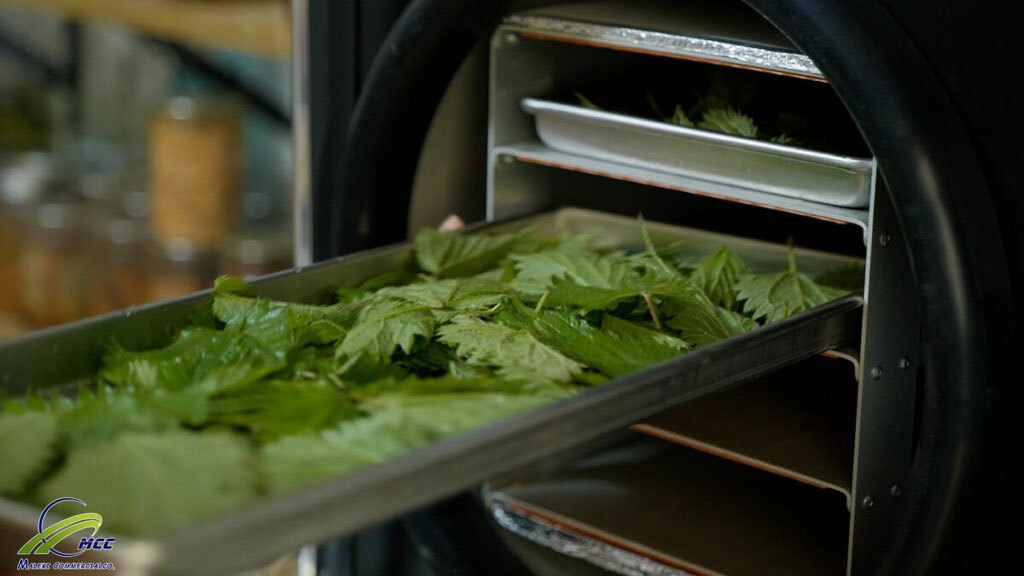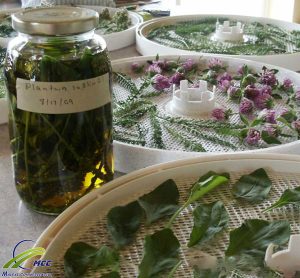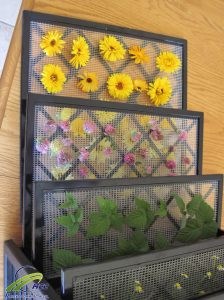When the organs of a plant contain the highest levels of active substances, it is necessary to proceed with the collection and drying of the respective plant.
- The active ingredients present in the vegetative parts during the flowering period are of the best quality, as the fully opened flowers contain the highest concentration of medicinal substances.
- Before the growth of plants (early spring), the skins of plants contain the highest amounts of active substances.
- In the late growth period (fall and spring), underground parts of plants such as roots and rhizomes have the highest concentration of active ingredients.
- Fruits and seeds of medicinal plants are rich in active ingredients when fully ripe.
- Leaves, stems, flowers, roots, and skins have the highest moisture content after harvesting, and the presence of moisture can lead to fungi and diseases. Therefore, immediate drying of medicinal plants should be undertaken right after harvest to prevent these issues.
What is drying?
The first step after harvesting a plant is moisture removal, known as drying.
Drying is defined as the reduction of moisture content in the product and the inhibition of enzymatic and microbial activity in the plant. This process allows for the long-term preservation of the plant.
The drying method depends on the level and type of moisture present in the plant parts.
The drying duration depends on temperature conditions and the ventilation system. A higher air temperature and more efficient ventilation lead to faster drying.
Medicinal plants are highly sensitive, and using high temperatures for drying should be avoided.
Important considerations for drying medicinal plants include:
- If high temperatures are employed for the drying of medicinal plants, the water present in the outer parts rapidly evaporates. However, in the inner sections of the plant organs, it does not escape. Accordingly, the outer parts of the plant organs turn brown and brittle, while the moisture retained in the inner sections leads to the decomposition and deterioration of the active constituents.
- The optimal temperature for drying parts containing essential oils is 40 to 50 ° Higher temperatures can lead to a reduction in essential oils.
- Parts containing vitamins require a temperature of 80 °C. Using higher temperatures may result in vitamin degradation.
- The ideal temperature for drying parts containing alkaloids is 60 to 70 °C.
- Temperatures exceeding 80 °C cause chlorophyll breakdown, resulting in a brown color.
Three factors should be considered for drying medicinal plants:
- Maintaining the level of active ingredients.
- Preserve external characteristics such as color, aroma, and taste.
- Avoiding undesirable economic impacts on the product.
After drying, medicinal plants should ideally maintain a moisture content ranging from approximately 10 to 40%. Despite this moisture level, it is possible to store the plants for a relatively extended period without causing serious damage to their active constituents and other characteristics.
Moisture content below the stated value not only reduces the medicinal effect of the active ingredients, but the use of such medicines is also uneconomical.
Preparing medicinal plants before drying
- After collecting the desired plant, it is essential to prepare a suitable environment for drying.
- The method of preparing plants not only accelerates the drying process but also affects the drying quality.
- By separating and isolating the additional components from the targeted plant organs and dividing the main organs into appropriate segments, not only is less energy consumed in the drying process, but the drying process is expedited.
- To dry roots and rhizomes, it is essential to first thoroughly wash them. For this purpose, it is advisable to place the mentioned organs in mobile water-draining containers and then wash them under water pressure.
- It is crucial to separate the skin of the roots, which lacks active substances, and then proceed to cut the roots into pieces.
- If the roots are thick, they should be divided into two or four parts lengthwise.
- If the goal is to use the leaves of medicinal plants, especially on a small scale, it is preferable to dry the fresh leaves separately instead of drying the entire plant. This approach ensures that the leaves, once dried, remain unadulterated and possess a higher quality.
Devices and used methods for drying medicinal plants
Both natural and artificial methods are employed for drying various parts of medicinal plants;
Natural method
- This method relies on sunlight exposure, and climatic variations such as heavy rainfall and high humidity are not suitable for its implementation.
- To prevent damage from climatic changes, plant organs are dried in rooms or dedicated drying halls.
- Drying large-scale plantings requires spacious and suitable halls, and plant parts to be dried should be rotated periodically.
- In this method, plants are placed on wire-mesh trays with suitable holes, allowing air to circulate easily without the need for flipping the plant.
- If the desired plant is properly placed on these mesh trays (with appropriate quantity), its quality will be maintained after drying.
- The standard size for drying on each wire-mesh tray (every m2 space) is 0.5kg of fresh flowers 2-5 kg of skin and roots, or 1 to 2 kg of fresh leaves.
- The time required for drying plants in the natural method depends on climatic conditions.
- In case of rain, not only will the plant parts not dry, but they will also absorb moisture, increasing their moisture content and promoting the growth of fungi and bacteria.
- If the weather conditions are suitable, the storage area’s door should be opened to allow air circulation. Furthermore, it is advisable to change the positions of the racks to ensure uniform drying of all parts of the plant.
Artificial Method
- This method relies on warm air circulation and the presence of a ventilation system that facilitates the movement of warm air.
- This method dries plants faster than the natural method and requires less labor.
Artificial dryers come in three types:
- Dryers with warm air circulation:
These dryers have high efficiency and speed compared to cool air circulation dryers and are commonly used for drying plants.
The plant quickly undergoes air circulation in this model, and the opposite direction of the airflow enhances the drying process.
Plants dry in a short period with this type of dryer.
Dryer models equipped with warm air circulation;
Belt dryers
This type of dryer has warm air circulation, and temperature, humidity, and ventilation speed can be easily adjusted.
No need to stop the device from unloading the plant.
It can dry 8 to 14 tons of fresh plants every 24 hours.
This dryer has high efficiency and requires less labor.
However, it has the drawbacks of high energy consumption and being expensive.
Cabinet dryers
This dryer is one of the most common dryers globally and occupies a small space.
Plant organs dry satisfactorily in this type of dryer, as air circulation takes place at specific intervals.
Not suitable for drying stems and branch-like branches, as these parts dry due to movement.
In this type of dryer, filling the dryer trays and loading the designated containers in the dryer require manual labor. After the plant is dried, it needs to be manually removed. Economically, considering the labor costs, it may not be cost-effective, and it has a relatively slower operation compared to other devices.
Cool air circulation dryers
In this method, the temperature used for drying the plant is the same as the ambient temperature.
The cool air mentioned is essentially the regular air that has entered the system, and through appropriate ventilation, it induces air circulation within the system. This results in the cooling of the environment.
The use of this method is only feasible on warm and dry days. This is because, in conditions where the air humidity exceeds 50%, the humidity inside the dryer increases, making it unsuitable for effective drying.
The time required for drying ranges from 8 to 20 days and depends on weather conditions.
If cooling systems, in addition to proper ventilation, are equipped with specialized devices to control the temperature effectively, it accelerates the drying process of plant organs. The use of this method ensures a more confident and efficient drying of seeds, fruits, and other plant parts.
If the outside air is humid and rainy, turning on the heater can neutralize the humidity.
This method is not cost-effective due to its lengthy drying time.
Drying with hot air flow method
In this method, a temperature between 200 to 1000 °C is used, and the desired product is dried within 2 to 5 min.
This system is capable of drying nearly two tons of fresh produce.
This method is used for drying agricultural products and fodder.
It is used much less for drying medicinal herbs because the used fuel in these devices is either oil or diesel. These fuels negatively affect the plant parts and the product’s quality.
Effects of drying on plants:
- Drying reduces the water content in various plant parts, resulting in a reduction in plant weight.
- Every 4 to 8 kg of fresh flowers yield 1 kg of dried flowers. Furthermore, every 4 to 5 kg of branches with leaves and flowers yields 1 kg of dried plant.
- Every 5 to 6 kg of fresh leaves yield 1 kg of dried leaves, and every 3 to 4 kg of fresh roots yield 1 kg of dried roots.
- Excessive reduction in water content in plant parts affects the active ingredients and plant quality.
- Plants containing essential oils experience a reduction in their essence if not dried immediately.
- Rapid and complete drying helps preserve the color and essence of the plants.
- Drying induces changes in the taste, aroma, and color of dried plant organs. For the market supply of these products, their characteristics must undergo multiple quality tests. If approved, they can then be introduced to the market.
 Wholesale of medicinal plants in Maleki Commercial
Wholesale of medicinal plants in Maleki Commercial
- In Maleki Commercial, various rare medicinal plants are available in bulk with diverse packaging.
- The product basket in this holding includes dried medicinal plants, rare gums, dates, and organic and natural essences.
- These plants are cultivated in supervised fields by experts in medicinal plants, harvested, and then dried using standardized methods. They are exported to various countries in diverse and standard packaging.
Some of the most important rare export plants that are provided in this business with standard and high-quality packaging are bitter asafoetida gum, sweet asafoetida gum, tragacanth gum, galbanum gum, coltsfoot root, organic damask rose essential oil, galbanum oil, galbanum essential oil, organic rose, etc.
For more information on asafoetida gum and tragacanth, which are rare plants, please refer to the following link:




